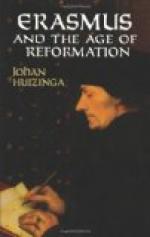At that time visits of ceremony were in great vogue. Officials and scholars alike groaned under them. After a visit to the Court Erasmus writes: ’If Pollio (a disguised name, as he was writing of a man who afterwards became an intimate friend) has been with you, you will understand what I suffered at Brussels; every day hosts of Spanish visitors, besides Italians and Germans.’ A little later he apologizes to a correspondent for having given him a chilly welcome: ’just then I had escaped from Brussels, quite worn out with the salutations of these persistent Spaniards.’ The custom was widespread. An English graduate, studying for a time at Louvain, congratulates himself on having escaped from it at Cambridge. Clenardus found it thriving at Salamanca; Casaubon complained of it at Montpellier; in Oxford it was even obligatory for intending disputants in the schools to pay formal visits beforehand to their examiners.
In 1517 Erasmus’ fame was at its zenith; and in consequence visitors came to him from every side, some to seek counsel, others to adore. His correspondence gives us many instances. In the spring of 1517, when the Cardinal of Gurk attended Maximilian to the Netherlands, his two secretaries, Richard Bartholinus of Perugia and Ursinus Velius, a Silesian, prepared panegyrical verses with which to greet Erasmus if they should have the good fortune to meet him. For some reason Bartholinus alone came, and, presenting both the poems, elicited a complimentary letter in reply. A more distinguished visitor received less attention. In the summer of 1518 Erasmus was at Basle, printing the notes to his second edition of the New Testament. The Bishop of Pistoia, nephew of one of the most influential cardinals, and Papal nuncio in Switzerland, also came to Basle. Wishing to see the great scholar, he asked him to dinner. But Erasmus could not spare the time. He declined, and in his place sent his friends, Beatus Rhenanus and the young Amerbachs. Three times he made excuse; and at length the Nuncio went on foot to seek in Froben’s press the scholar who would not come to him. What their conversation was we do not know; but before leaving, the Nuncio ordered a copy of the Amerbach-Froben Jerome to be sent to the binders and equipped with his arms and adornments.
Later in the year the enthusiastic Eobanus of Hesse appeared in Louvain. He had come from Erfurt where he was teaching, and the main purpose of his journey was to see Erasmus. His Hodoeporicon, printed on his return, describes his course in detail. With a young companion, John Werter, also from Erfurt, he entered Louvain in the evening. Next morning early they sent in their ‘callow’ verses to the great man, and followed shortly themselves. Erasmus came down to greet them at the door with a kindly welcome, and Eobanus describes a banquet to which he invited them, entertaining them with serious talk and light-hearted jest. But it was at no light cost to Erasmus’ time: for when his




